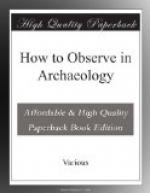Pre-Semitic Period (down to circa 2000 B.C.). Ware hand-modelled, without wheel, coarse, gritty, and generally soft-baked and very porous. The section of a clean fracture is usually of a dirty yellowish colour, resembling in appearance coarse oatmeal porridge. Bases usually flat, loop-handles or wavy handles on the bodies of the vessels: mouths wide and lips curved outward. The body of the vessel often decorated with drip lines or with a criss-cross, in red paint.
First Semitic Period (circa 2000-1800 B.C.). Similar to the last: but the potter’s wheel is used, and horizontal painted and moulded rope-like ornament also found. Combed ornament and burnished lines frequent.
Second Semitic Period (circa 1800-1400 B.C.). During this period imports from Egypt, Crete, the Aegean Sea, and especially Cyprus were common, and potsherds originating in those countries are frequently to be picked up: also local imitations of these foreign wares. The ware of this period is on the whole well-refined and well-modelled: the most graceful shapes, in jugs and bowls, belong to it. Elaborate polychrome decoration, including figures of birds. But little moulded ornament.
Third Semitic Period (circa 1400-1000 B.C.). The same foreign influences are traceable, but rather as reminiscent local imitations than as direct imports. Late Minoan [Mycenaean] sherds are, however, frequent. The shapes of vessels are less artistic than in the preceding period: the painted ornament is also degenerated, being traced in wiry lines rather than in the bold wash of the preceding period.
Fourth Semitic Period (circa 1000-550 B.C.). Late Cypriote imports. The local ware very poor, coarse, gritty, inartistic. No painted ornament except mere lines: clumsy moulded ornament frequent.
Post-Exilic and Hellenistic Period (circa 550-100 B.C.). Imports from Greece (sometimes fragments of black or red figured vases, or lekythoi) and from the Aegean Islands (especially wine-jars from Rhodes: stamped handles of such are frequent). The native ware is easily recognizable by its smoothness and hardness; when struck with a stick a sherd emits a musical clink. The vessels are very fair imitations of classical models, occasionally with painted ornament, but more frequently moulded.
Roman and Byzantine Period (circa 100 B.C.-A.D. 600). The unmistakable character of the ware of this period is the ribbed surface, with which nearly all vessels are decorated. Fragments of ribbed pottery are strewn almost over all Palestine. Ornament consisting of repeated impressions of stamps now begins to appear. Lamps with decoration, inscriptions, Christian or Jewish symbols common. Glass vessels also frequent.
Arab Period (circa A.D. 600 onwards). The early Arab ware often bears painted decoration singularly like that on Second and Third Semitic pottery, but a fatty soapy texture characterizes the Arab ware, which is absent from the earlier sherds. There is likewise a complete absence of representation of natural forms (birds and the like). In or about the Crusader period the use of ornamental glaze makes its appearance.




